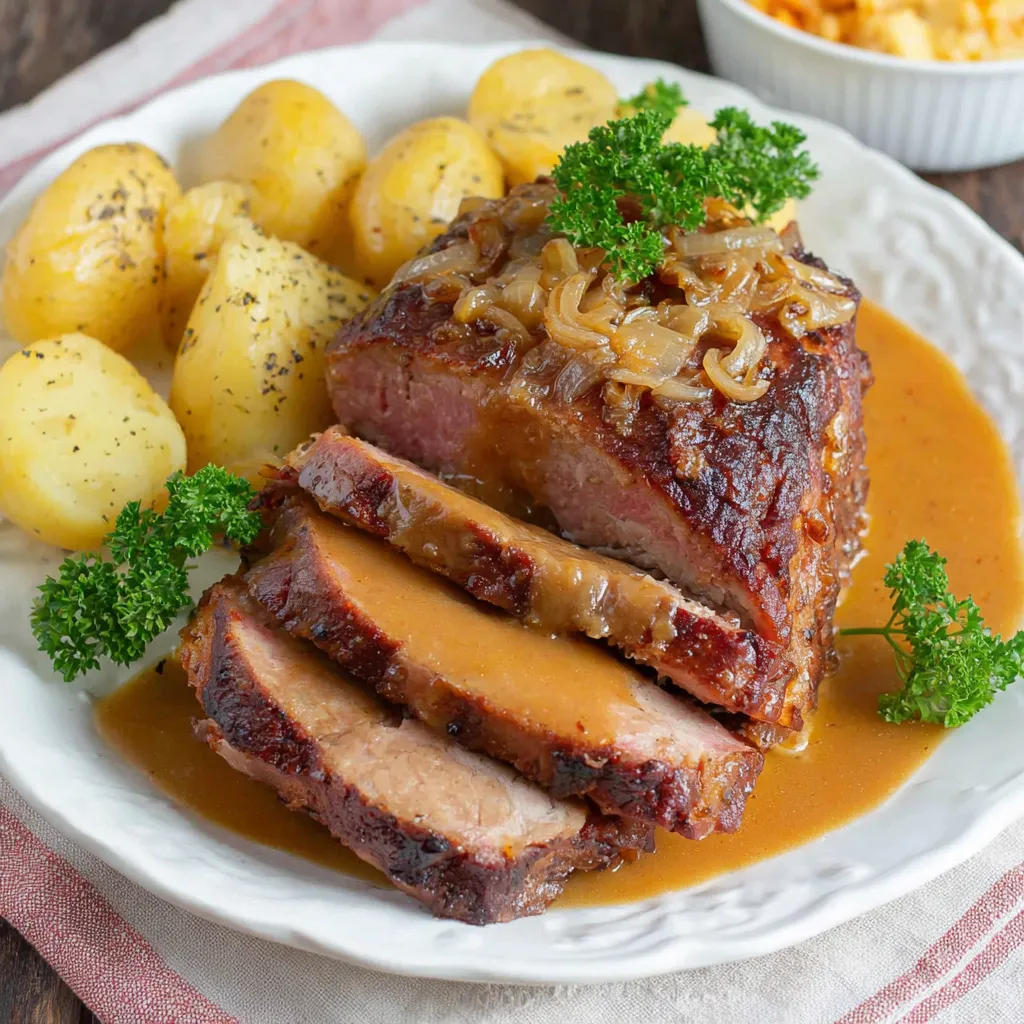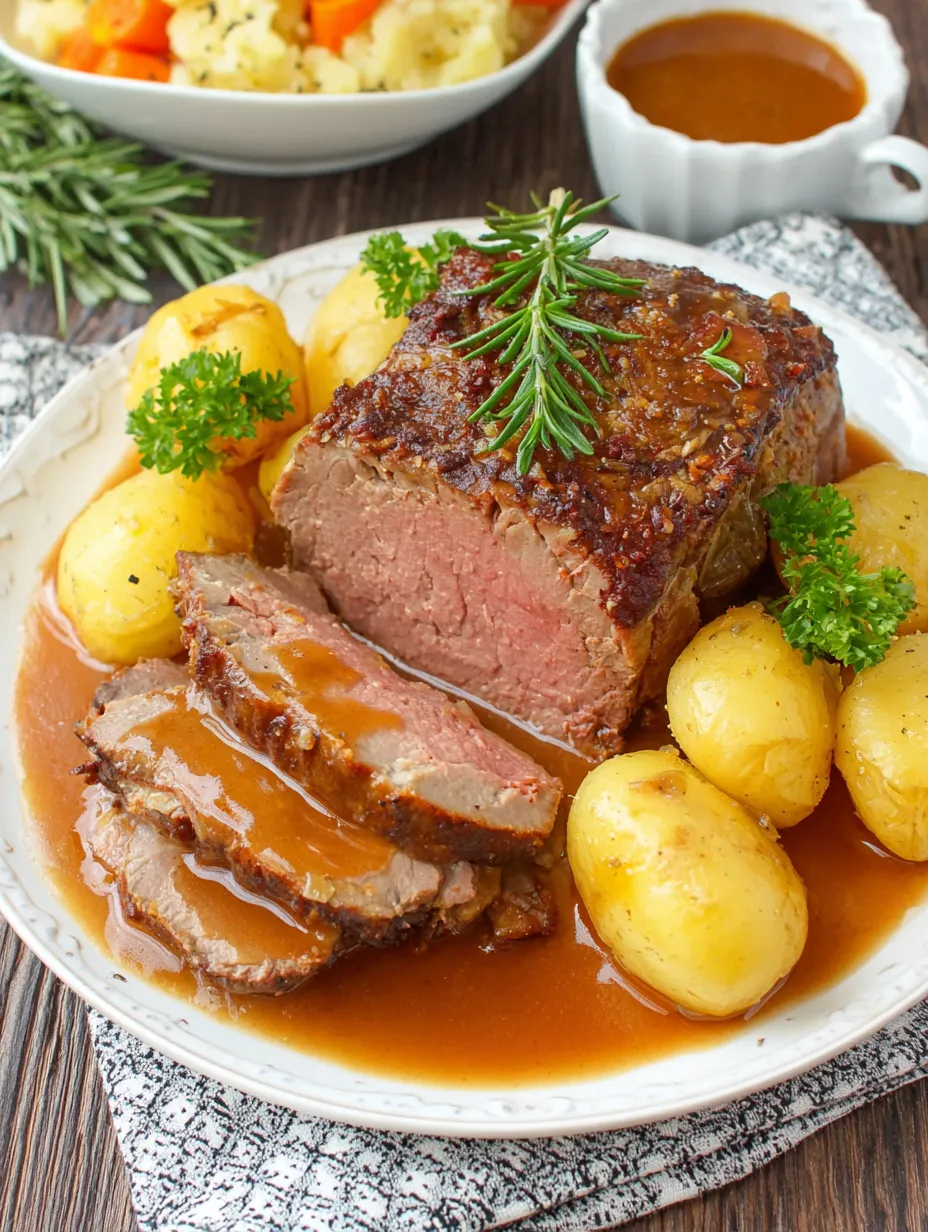 Save
Save
Kasslerbraten im Ofen is the absolute definition of a comforting family meal. Slow cooked cured pork neck becomes incredibly tender and flavorful with a rich, oniony gravy. Every time I make this for guests, it is the ultimate guarantee of warm smiles and clean plates.
Ingredients
- Kasslerkamm one point two kilogram: Choose a well marbled cured pork neck for full flavor and juiciness
- Zwiebeln six: Large yellow onions will break down into the sauce adding sweetness and body
- Butterschmalz or neutral oil: Get real butterschmalz if possible for a traditional flavor and rich browning
- Salz: Fine sea salt draws out the pork flavor best
- Pfeffer: Freshly cracked black pepper is essential for balanced seasoning
- Kümmel: Whole seeds give a signature herbal bite choose whole seeds and crush lightly for best effect
- Majoran: Use dried marjoram for classic German notes it pairs beautifully with pork
- Butter one tablespoon: Choose European butter for extra depth in the sauce
- Weizenmehl two tablespoons: Go for plain wheat flour for a smooth and silky gravy
Step-by-Step Instructions
- Zwiebeln vorbereiten:
- Peel all onions and cut into eighth wedges so they cook down evenly and help thicken the gravy
- Fleisch und Zwiebeln anbraten:
- Heat butterschmalz in a large roasting pan or deep skillet over medium-high. Add Kassler and onion wedges. Season the meat all over with pepper and sear it on every side until deeply golden and crisp. Turning the roast is key for color and flavor development. This takes about five minutes and infuses your kitchen with mouthwatering aromas
- Ab in den Ofen:
- Pour just enough hot water into the pan to reach about one centimeter up the side. Cover tightly with a lid. Place the pan in a preheated oven set to two hundred Celsius top and bottom heat. Let the pork slowly braise for two to two and a half hours. Every thirty to forty minutes remove the lid and baste the roast with broth or more water to keep it juicy and prevent dryness
- Garpunkt prüfen:
- The roast is ready when a sharp knife glides in easily and the meat nearly falls apart. This is a signal the collagen has broken down fully guaranteeing tenderness
- Soße fertigmachen:
- Remove the pan from the oven and set it carefully on the stove. Lift out the pork with a meat fork and keep it warm under foil. Return the pan with onions and roasting juices to medium heat and pour in another splash of hot water. Season the gravy base generously with salt pepper caraway and marjoram until it tastes vibrant
- Einbrenne zubereiten:
- Melt the butter in a small skillet over medium low heat until nutty and golden never letting it darken too much. Stir in the flour to make a roux. Stir and cook until it picks up a toasty brown color about two to three minutes
- Soße vollenden:
- Whisk this roux into the onion and meat juices mixing very well until the sauce thickens and turns luscious brown. Most onion pieces will disintegrate perfectly into the gravy but if you want it extra smooth a quick blend works wonders
- Servieren:
- Slice the Kasslerbraten and serve with the gravy over top. Traditional sides are sauerkraut and boiled potatoes though creamy mashed potatoes or crusty bread work just as well too

My favorite ingredient here is the caraway which lifts the whole gravy to a new level. Every time this dish hits the table I remember cozily gathering with my family at holidays savoring every bite and laughing over seconds.
Storage Tips
Leftover Kasslerbraten keeps beautifully covered in the fridge for up to three days. Let it cool fully before storing so no condensation makes the sauce watery. For the best results reheat slices gently in leftover gravy over low heat until just warmed through. If you want to freeze the roast do so in sliced portions with extra sauce to prevent it from drying out. Thaw overnight in the fridge before reheating slowly.
Ingredient Substitutions
If you cannot find Kasslerkamm look for smoked pork loin or even a smoked pork shoulder for the closest flavor and texture. If butterschmalz is not available use a neutral oil plus a little butter for browning. Dried oregano can step in for marjoram if needed and all purpose flour works in place of wheat flour for thickening.

Serving Suggestions
This roast loves classic German sides like sauerkraut with apples or braised red cabbage. I often add boiled or mashed potatoes that soak up all that savory sauce. For a lighter meal pair with roasted root vegetables or even a crisp green salad.
Cultural Context
Kasslerbraten is a beloved staple in German kitchens found everywhere from home tables to cozy restaurants. The curing and smoking method adds both flavor and preservation a tradition rooted in making the most of pork. Each family puts their stamp on the dish with different spice blends and gravies—my own recipe is a mix of what my grandmother taught me and tips picked up from friends.
Recipe FAQs
- → Wie bleibt der Kasslerbraten besonders saftig?
Achte darauf, das Kassler beim Schmoren regelmäßig mit Bratensaft oder Wasser zu übergießen. Die Abdeckung im Ofen schützt vor Austrocknen.
- → Welche Beilagen passen dazu?
Klassisch schmeckt der Braten am besten mit Sauerkraut und Salzkartoffeln, aber auch Kartoffelstampf oder Knödel sind eine passende Wahl.
- → Kann man das Gericht einen Tag vorher zubereiten?
Ja, der Geschmack wird sogar intensiver, wenn der Braten über Nacht durchzieht und am nächsten Tag sanft erwärmt wird.
- → Welche Gewürze passen zum Kassler aus dem Ofen?
Pfeffer, Salz, Majoran und Kümmel harmonieren besonders gut. Wer mag, kann etwas Knoblauch hinzufügen.
- → Wie gelingt die Soße besonders aromatisch?
Eine kräftige Einbrenne aus Butter und Mehl, der Bratensaft sowie pürierte Zwiebeln ergeben eine aromatische, sämige Soße.
